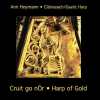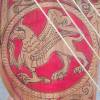
|
The early Gaelic song traditions of Ireland and Scotland are intimately connected to the early Gaelic harp traditions. From earliest times right up to the decline and extinction of the Gaelic harp in the 18th and 19th century, the early Gaelic harp was used to accompany Gaelic singing.

16th century print of harper & singer
There seems to have been two different ways that the Gaelic harp was used to accompany song; either a single person would sing while also playing the harp to accompany themselves, or two people would perform together, one singing while the other played the harp.
The Gaelic harp, with its metal strings of brass, silver and even gold wire, is very different from the modern lever harp with strings of gut. The early Gaelic harp is not suitable for a romantic chordal accompaniment; instead, it seems likely that a melodic or figured accompaniment may have been used.
Whereas the Gaelic song tradition is still very much alive today, and there is plenty of early documentation for the instrumental playing techniques and repertory of the early Gaelic harp, there is much less information available on the use of the early Gaelic harp in accompanying Gaelic song. You can listen to some examples of recent work in this field:

Charlie Heymann, Gaelic song, with Ann Heymann, Gaelic harp: Airrgeann Mór.
Medieval; lay text from Duanaire Finn c.1500; melody from Bunting manuscripts c. 1800.
Track 7 on the CD, Ann Heymann: Cruit go nÓr (Clairseach CMCD0706, 2006). See www.harpofgold.net

Bríd Ní Mhaoilchiaráin, Gaelic song, with Siobhán Armstrong, Gaelic harp: Seabhac na hÉirne by Turlough Carolan.
early 18th century; text & melody from Bunting manuscripts c. 1800
Track 5 on the CD, Siobhán Armstrong: Cláirseach na hÉireann - The Harp of Ireland (Maya MCD0401, 2004). Listen online

Mairead Murnion, Gaelic song, with Simon Chadwick, Gaelic harp: Oran air Cath Sliabh an t Siorraimh.
early 18th century; text from Robertson family papers; melody from Bowie 1789
Track 20 on the CD, Simon Chadwick: Clàrsach na Bànrighe (Early Gaelic Harp Info EGH1, 2008). more info
Problems and issues for future work include:
- matching extant early Gaelic texts with their original melodies - in the past poems and tunes were written down quite seperately and so far very few have been successfully recombined.
- Exploring and discovering historical Gaelic vocal performance practice - though Gaelic singing is a living art today, there can be no doubt that traditions and techniques have changed over the centuries.
- Exploring and discovering historical Gaelic harp performance practice. That is what this website is devoted to.
There is no point in doing huge amounts of scholarly work on the first two and then wasting it all by using a modern gut-strung lever harp to play the accompaniment. The unique voice of the early Gaelic harp with its metal strings of brass, silver and even gold wire has to be an essential part of early Gaelic song performance practice.